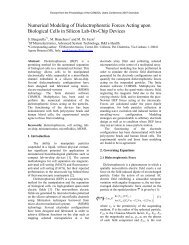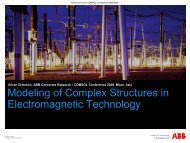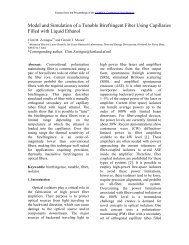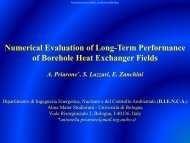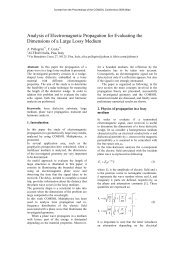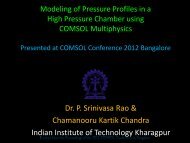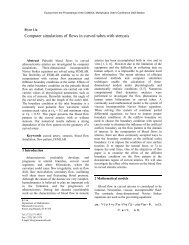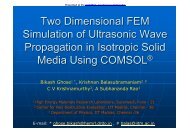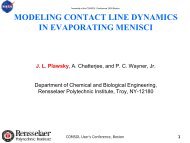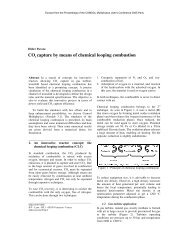Equation-Based Modeling: The Structural Contact ... - COMSOL.com
Equation-Based Modeling: The Structural Contact ... - COMSOL.com
Equation-Based Modeling: The Structural Contact ... - COMSOL.com
Create successful ePaper yourself
Turn your PDF publications into a flip-book with our unique Google optimized e-Paper software.
Excerpt from the Proceedings of the <strong>COMSOL</strong> Conference 2010 Paris<br />
<strong>Equation</strong>-<strong>Based</strong> <strong>Modeling</strong>: <strong>The</strong> <strong>Structural</strong> <strong>Contact</strong> Problem<br />
Solved by <strong>The</strong> Velocity Approach<br />
O. Toscanelli ∗,1 , V. Colla 1<br />
1 Scuola Superiore S. Anna<br />
∗ Viale Rinaldo Piaggio 34 - 56025 Pontedera (Pisa) Italy, tojfl@sssup.it<br />
Abstract:<br />
<strong>The</strong> contact between infinitely rigid body<br />
and deformable part is studied using the velocity<br />
as a dependent variable. A simple forging<br />
case is evaluated. <strong>The</strong> velocity approach is realized<br />
by mean <strong>COMSOL</strong> with the <strong>Equation</strong>-<br />
<strong>Based</strong> <strong>Modeling</strong> and the Deformed Mesh Module.<br />
<strong>The</strong> Anand’s material model is used for<br />
the no-linear part of material behavior.<br />
Keywords: contact, continuous, velocity, nonlinear,<br />
plasticity, Anand<br />
1 Introduction<br />
<strong>The</strong> contact among mechanical parts is a very<br />
important and difficult problem. Its mathematical<br />
modeling, theoretical and numerical,<br />
is a not concluded challenge. <strong>The</strong> aim of this<br />
work is to evaluate a simple contact model using<br />
the velocity as dependent variable [1] . A<br />
small amount of penetration is permitted in<br />
this contact model and a corresponding system<br />
of reactions stress is applied to the surface<br />
of deformable part. <strong>The</strong> contact have not<br />
friction.<br />
To handle and solve equations is used<br />
<strong>COMSOL</strong> with its <strong>Equation</strong>-<strong>Based</strong> <strong>Modeling</strong><br />
and Deformed Mesh Module.<br />
2 Governing <strong>Equation</strong>s<br />
<strong>The</strong> structural equations used here are the<br />
same of [1] . Only momentum balance and<br />
constitutive equations are considered. <strong>The</strong><br />
temperature θ and the density ρ are constant<br />
and uniform. <strong>The</strong> momentum balance is expressed<br />
by<br />
ρ ∂ t v i + ρ v · ∇v i = ∂ j σ ij + f i (1)<br />
<strong>The</strong> Anand’s plasticity model [2] is expressed<br />
by<br />
T ∇ = L (D − D p ) (2)<br />
Where<br />
v is the velocity,<br />
f is the body force,<br />
T is the Cauchy stress tensor (T ij ≡ σ ij ),<br />
Tij ∇ ≡ ∂ tσ ij + v l ∂ l σ ij − W il T lj + T il W lj ,<br />
L ≡ 2µI +[k −(2/3)µ]1⊗1 is the fourth order<br />
isotropic elasticity tensor,<br />
D ≡ sym(L) is the stretching tensor (L ij ≡<br />
∂ j v i ),<br />
W ≡ skew(L) is the spin tensor,<br />
D p ≡ ˜ɛ ˙ p (3/2)(T ′ /˜σ) is the flow rule,<br />
T ′ is the deviator of the Cauchy stress tensor,<br />
˜σ = √ (3/2)T ′ · T ′ is the equivalent tensile<br />
stress,<br />
˜ɛ ˙ p ≡ A exp (−Q/(Rθ)) (sinh (ξ˜σ/s)) 1/m is the<br />
flow equation,<br />
ṡ = h 0 |1 − s/s ∗ | a sign (1 − s/s ∗ ) ˜ɛ ˙ p is the evolution<br />
equation with<br />
s ∗ = ˜s [ ˜ɛ ˙ p /A exp (Q/(Rθ)) ]<br />
Where θ is the temperature in K.<br />
<strong>The</strong> material parameters are: k, µ (Hooke and<br />
Anand), A, Q, m, ξ, h 0 , a, ˜s, s 0 (Anand).<br />
<strong>The</strong> reaction stress in the point P is <strong>com</strong>puted<br />
by<br />
σ r =<br />
f r = σ r n (3)<br />
{<br />
kc δ δ < 0<br />
0 δ ≥ 0<br />
(4)<br />
Where P is a point of the surface of the deformable<br />
body, n is the normal to this surface<br />
and δ is the distance from P to the surface of<br />
the rigid body (if δ < 0 there is penetration).<br />
<strong>The</strong> contact stiffness is k c .<br />
3 Methods<br />
To study this contact model a simple forging<br />
case is simulated. <strong>The</strong> tool (the rigid body)<br />
is a sphere, the work-piece (the deformable<br />
body) is a hexahedron. Anand’s material<br />
model is adopted. To execute this task, deformed<br />
geometry, displacements, stresses and<br />
penetration are evaluated.
4 Numerical Model<br />
<strong>The</strong> simulations are performed with the software<br />
<strong>COMSOL</strong> 3.5a and on a 2 Quad-Core<br />
AMD Opteron(tm) Processor 2356 8GB RAM<br />
Linux WS.<br />
<strong>The</strong> elements utilized are Lagrange-linear<br />
hexahedron generated with a mapped mesh<br />
procedure. All the simulations are transient.<br />
<strong>Equation</strong>-<strong>Based</strong> Modelling and Deformed<br />
Mesh Module are utilized.<br />
<strong>The</strong> Radius of the sphere is 0.1 m, the sides of<br />
the hexahedron are (0.05, 0.1, 0.1) m, the velocity<br />
of the sphere is (−0.001, 0, 0) m/s. <strong>The</strong><br />
contact stiffness is 1E+12 N/m 3<br />
Only a quarter of the work-piece is modeled<br />
utilizing two plane of symmetry (Y = 0,<br />
Z = 0).<br />
<strong>The</strong> sphere is analytically defined and do not<br />
have a geometry to show in <strong>COMSOL</strong>.<br />
For the coordinate system has been adopted<br />
the <strong>COMSOL</strong> nomenclature: (x, y, z) ale<br />
is<br />
the spatial frame, (X, Y, Z) ref<br />
is the reference<br />
frame.<br />
<strong>The</strong> material parameters are reported in the<br />
following tables.<br />
Hooke<br />
Anand<br />
E 70 MPa E 105 GPa<br />
ν 0.3 ν 0.41<br />
A 6.346 E+11 s −1<br />
Q 312.35 kJ/mol<br />
m 0.1956<br />
ξ 3.25<br />
h 0 3093.1 MPa<br />
a 1.5<br />
˜s 121.1 MPa<br />
R 8.314472 J/(mol K)<br />
s 0 66.1 MPa<br />
6 Discussion<br />
<strong>The</strong> deformed geometry and displacements obtained<br />
from <strong>COMSOL</strong> are those foreseen. <strong>The</strong><br />
penetration δ is just for the mesh and element<br />
utilized. So, the goodness of the <strong>COMSOL</strong><br />
simulation is demonstrated.<br />
7 Conclusions<br />
<strong>The</strong> contact model evaluated in this work is<br />
suitable to model the forging process. <strong>The</strong><br />
simulation have not special numerical difficulties.<br />
For a given mesh and element it is possible<br />
to choose the optimum value of k c avoiding<br />
numerical not-convergence.<br />
8 Use of <strong>COMSOL</strong> Multiphysics<br />
<strong>COMSOL</strong> <strong>Equation</strong>-<strong>Based</strong> Modelling and Deformed<br />
Mesh Module are tools very suitable<br />
for the task to evaluate different and new contact<br />
models.<br />
9 Figures<br />
<strong>The</strong> Anand’s parameters are pertinent to a<br />
BCC polycrystalline Fe-2% silicon alloy at a<br />
temperature θ = 1000 C [2].<br />
5 Experimental Results<br />
<strong>The</strong> results are reported in the next pictures<br />
and graphs. In pictures from 1 to 4 the x <strong>com</strong>ponent<br />
of the displacement u at various time<br />
is reported.<br />
In pictures from 5 to 8 the penetration δ at<br />
various time is reported.<br />
In picture 9 the Von Mises’s equivalent stress<br />
is reported.<br />
In picture 10 the forging force is reported.<br />
Figure 1: u x(t = 10 s)
Figure 2: u x(t = 20 s)<br />
Figure 4: u x(t = 40 s)<br />
Figure 3: u x(t = 30 s)<br />
Figure 5: δ(t = 10 s)
Figure 6: δ(t = 20 s)<br />
Figure 9: σ e(t = 40 s)<br />
Figure 10: forging force<br />
Figure 7: δ(t = 30 s)<br />
References<br />
[1] M. Vannucci O. Toscanelli, V. Colla,<br />
<strong>Equation</strong>-based modelling: True large<br />
strain, large displacement and anands plasticity<br />
model with the <strong>com</strong>sol deformed<br />
mesh module, <strong>COMSOL</strong> CONFERENCE<br />
2009.<br />
[2] Kwon H. Kim Stuart B. Brown and Lallit<br />
Anand, An internal variable constitutive<br />
model for hot working of metals, International<br />
Journal of Plasticity 5 (1989),<br />
95–130.<br />
Figure 8: δ(t = 40 s)



![[PDF] Microsoft Word - paper.docx - COMSOL.com](https://img.yumpu.com/50367802/1/184x260/pdf-microsoft-word-paperdocx-comsolcom.jpg?quality=85)
